You are using an out of date browser. It may not display this or other websites correctly.
You should upgrade or use an alternative browser.
You should upgrade or use an alternative browser.
It followed me home (Part 2)
- Thread starter Steve Tall
- Start date
- Joined
- Dec 17, 2018
- Messages
- 1,192
LoL. It’s hard to convey how big it is.
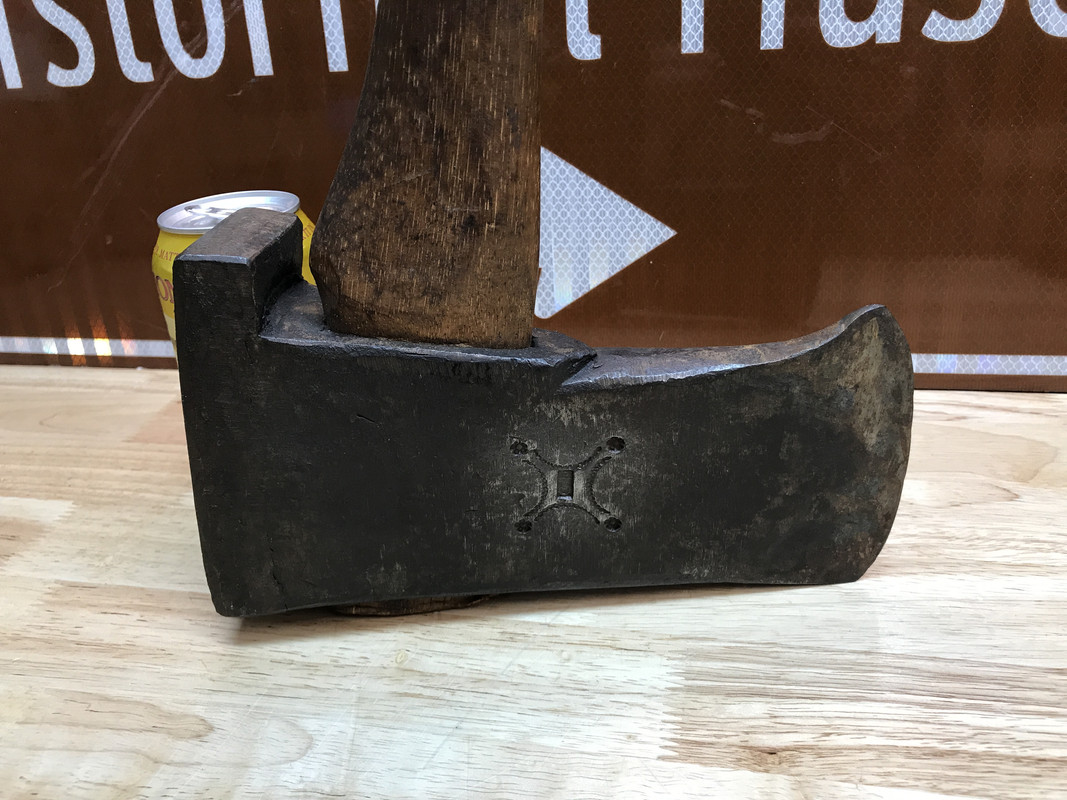

- Joined
- Feb 28, 2009
- Messages
- 416
I have not seen one of those in my lifetime. I wonder if the big poll was an after thought addition to the first one or two? Needs more mass to split better? Gosh, now that we have it stuck, what should we do? I think a big bowl of Wheaties and a pound or two of bacon would be needed to start the day off with if a fellow was intending to swing that all day! I am a bit curious what book page 74 is from? It seems I have always been drawn to unique things, perhaps that is why axes and logging tools in general have kept my interest, there certainly is variety. Your Holzaxt is very cool and a nice find!
Last edited:
- Joined
- Dec 17, 2018
- Messages
- 1,192
That’s from Tom Lamond's(the yesteryear tools guy) Axes and Associated Hand Tools. It’s a great resource!I have not seen one of those in my lifetime. I wonder if the big poll was an after thought addition to the first one or two? Needs more mass to split better? Gosh, now that we have stuck, what should we do? I think a big bowl of Wheaties and a pound or two of bacon would be needed to start the day off with if a fellow was intending to swing that all day! I am a bit curious what book page 74 is from? It seems I have always been drawn to unique things, perhaps that is why axes and logging tools in general have kept my interest, there certainly variety. Your Holzaxt is very cool and a nice find!
- Joined
- Feb 28, 2009
- Messages
- 416
Thank you for the title and author! I am afraid I read so much I married a librarian.That’s from Tom Lamond's(the yesteryear tools guy) Axes and Associated Hand Tools. It’s a great resource!
- Joined
- Mar 2, 2013
- Messages
- 1,772
I can't quite picture the mechanics of using the poll extension to pry the bit free, but ok, maybe there's a special kind of lever companion that goes with it, or you just use your can't hook, better than stressing the handle for sure. The beak on the bit is an intentional & functional element useful for hooking a billet and pulling it in. And it looks like the bit's also welded on.
The decorative stamping, composed of standard elements - crescents and flowers/fruit , the smids initials in the center- is in fact derived from the christian cross rather than the Tree of Life or Yggdrasil, similar ideas, the one predating the other. Just goes to show the Christians and Pagans were friends. The Tree of Life is a different composition though of which there are two versions common on axes, the barren and the fruitful or maybe it's the male and the female representation. In this stamp you show from AH we can see clearly the central cross and the repetition of the three stars representative of the godhead. It's my guess, 'cause I never saw it written down anywhere but I like to think the crescent's symbolic for the sky where Heaven's supposedly located and those three characters reside. You will typically see the cross and ToL/Y symbols together but obviously space here is limited.
Which reminds me of something very coincidental and timely. Just yesterday I randomly grabbed one axe from the rack to do some work and it happened to be also a small axe. This one has only space for an abbreviated ToL/Y on it.

The decorative stamping, composed of standard elements - crescents and flowers/fruit , the smids initials in the center- is in fact derived from the christian cross rather than the Tree of Life or Yggdrasil, similar ideas, the one predating the other. Just goes to show the Christians and Pagans were friends. The Tree of Life is a different composition though of which there are two versions common on axes, the barren and the fruitful or maybe it's the male and the female representation. In this stamp you show from AH we can see clearly the central cross and the repetition of the three stars representative of the godhead. It's my guess, 'cause I never saw it written down anywhere but I like to think the crescent's symbolic for the sky where Heaven's supposedly located and those three characters reside. You will typically see the cross and ToL/Y symbols together but obviously space here is limited.
Which reminds me of something very coincidental and timely. Just yesterday I randomly grabbed one axe from the rack to do some work and it happened to be also a small axe. This one has only space for an abbreviated ToL/Y on it.

Last edited:
- Joined
- Apr 20, 2017
- Messages
- 1,000
Super stoked that this axe found me. An old Holzaxt, a monster splitting maul of sorts with a Deutsch-Pennsylvania heritage.
It’s 9lbs. 12oz. With a 30” handle and a massive poll that is bigger than a beer can. The blacksmiths mark looks to have a Yggdrasil tree from the Norse tradition similar to one ofAgent_H Kirves.
The guy who owned it thought it might be a type of portable anvil, it is not.
The protrusion off the bottom of the poll is for using another tool to lever it out of the log if it becomes stuck.












Salute!
Oh. The Yggdrasil Tree on agentH’s
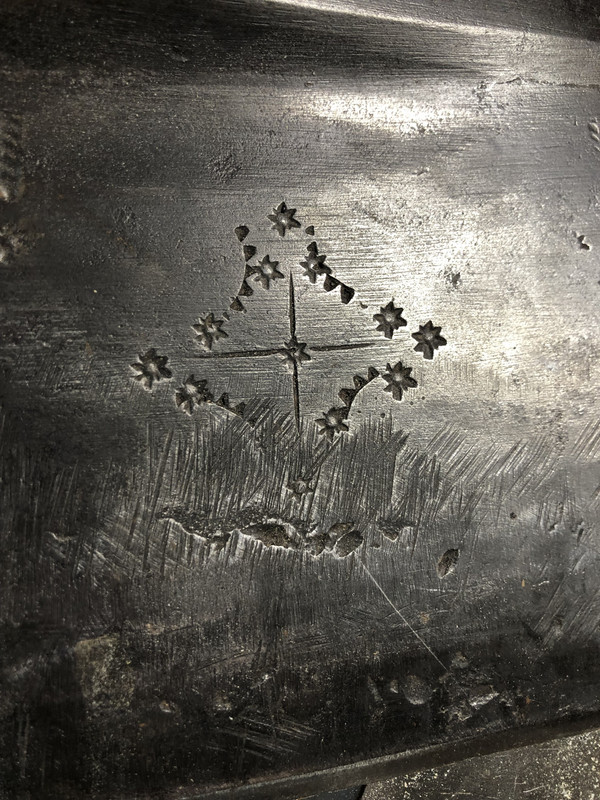
I had no idea how big that thing is until i saw it next to the beer can
Very, very cool.
- Joined
- Mar 2, 2013
- Messages
- 1,772
LoL. It’s hard to convey how big it is.

Why can't I get this to "play"?
- Joined
- Mar 2, 2013
- Messages
- 1,772
Oh.That's the sign behind the axe, I'm afraid
- Joined
- Dec 17, 2018
- Messages
- 1,192
Thanks for all the great insights Ernest! Sorry about the optical illusion.I can't quite picture the mechanics of using the poll extension to pry the bit free, but ok, maybe there's a special kind of lever companion that goes with it, or you just use your can't hook, better than stressing the handle for sure. The beak on the bit is an intentional & functional element useful for hooking a billet and pulling it in. And it looks like the bit's also welded on.
The decorative stamping, composed of standard elements - crescents and flowers/fruit , the smids initials in the center- is in fact derived from the christian cross rather than the Tree of Life or Yggdrasil, similar ideas, the one predating the other. Just goes to show the Christians and Pagans were friends. The Tree of Life is a different composition though of which there are two versions common on axes, the barren and the fruitful or maybe it's the male and the female representation. In this stamp you show from AH we can see clearly the central cross and the repetition of the three stars representative of the godhead. It's my guess, 'cause I never saw it written down anywhere but I like to think the crescent's symbolic for the sky where Heaven's supposedly located and those three characters reside. You will typically see the cross and ToL/Y symbols together but obviously space here is limited.
Which reminds me of something very coincidental and timely. Just yesterday I randomly grabbed one axe from the rack to do some work and it happened to be also a small axe. This one has only space for an abbreviated ToL/Y on it.
The poll is so wide where that protrusion is that it’s easy to get something under the edge of it. A hammer, prybar or any such thing would do, certainly a purpose made lever. I hooked it with back of a 1 1/5lb cross peen hammer for a demonstration, it worked.
And yes Fmont that beer is almost hidden behind it in that photo, I had to try to leave a little poking out, it is a monster!
- Joined
- Sep 3, 2014
- Messages
- 3,741
 IMG_20190913_083041 by Justin Lyttle, on Flickr
IMG_20190913_083041 by Justin Lyttle, on Flickr- Joined
- Dec 17, 2018
- Messages
- 1,192
Leave it toI can't quite picture the mechanics of using the poll extension to pry the bit free, but ok, maybe there's a special kind of lever companion that goes with it, or you just use your can't hook, better than stressing the handle for sure. The beak on the bit is an intentional & functional element useful for hooking a billet and pulling it in. And it looks like the bit's also welded on.
The decorative stamping, composed of standard elements - crescents and flowers/fruit , the smids initials in the center- is in fact derived from the christian cross rather than the Tree of Life or Yggdrasil, similar ideas, the one predating the other. Just goes to show the Christians and Pagans were friends. The Tree of Life is a different composition though of which there are two versions common on axes, the barren and the fruitful or maybe it's the male and the female representation. In this stamp you show from AH we can see clearly the central cross and the repetition of the three stars representative of the godhead. It's my guess, 'cause I never saw it written down anywhere but I like to think the crescent's symbolic for the sky where Heaven's supposedly located and those three characters reside. You will typically see the cross and ToL/Y symbols together but obviously space here is limited.
Which reminds me of something very coincidental and timely. Just yesterday I randomly grabbed one axe from the rack to do some work and it happened to be also a small axe. This one has only space for an abbreviated ToL/Y on it.

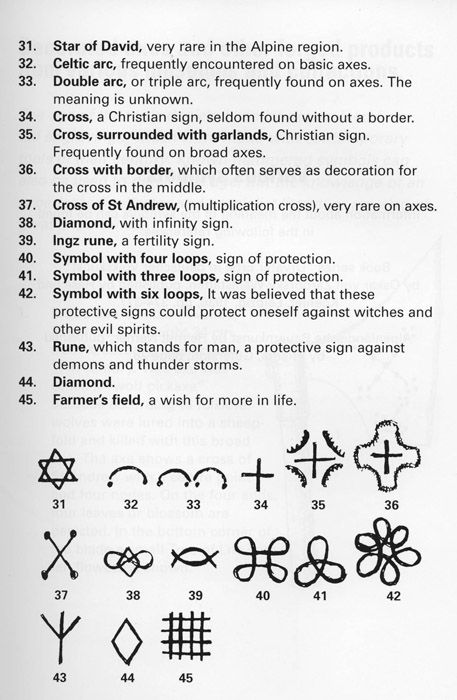
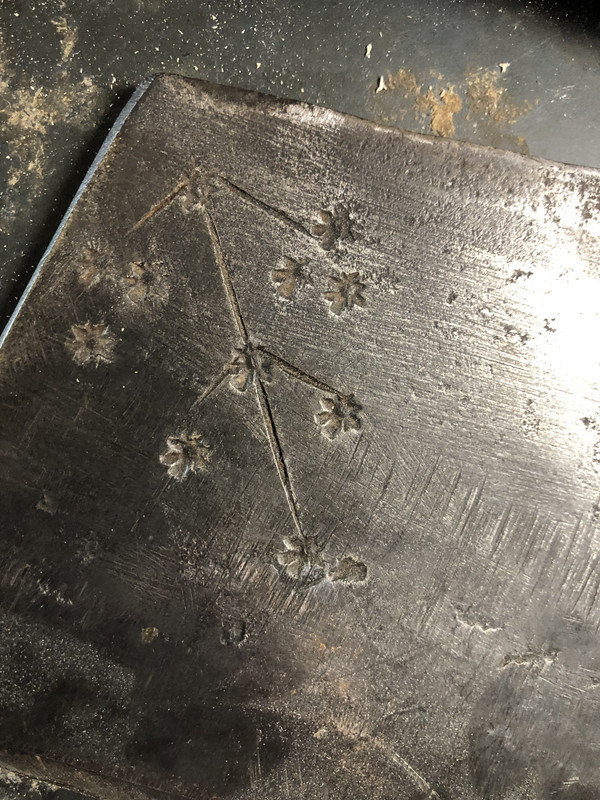
Last edited:
- Joined
- Aug 21, 2013
- Messages
- 3,898
Symbol #42 “against witches” is especially useful and quite specific.
I like to think there should be an arrow pointing to Midgard with the text, “You are here” lol.

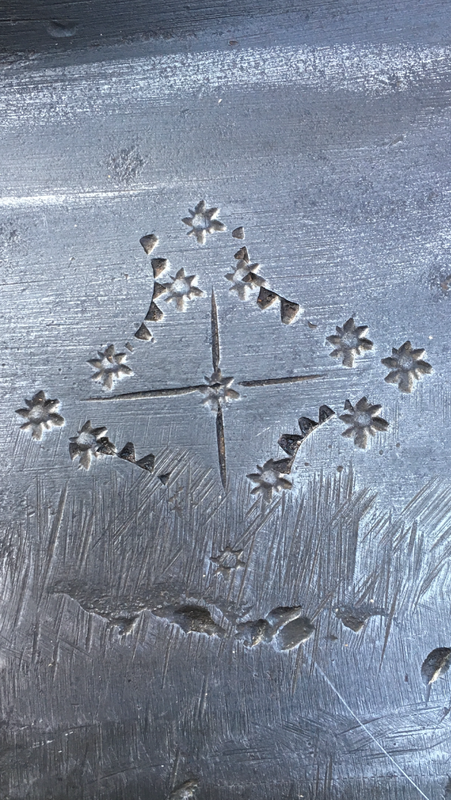
There probably were many versions and representations of Pagan/Christian symbolism arrived at over time and regions.
I don’t really know what the markings are with certainty but those styles of symbols interest me- that and they obviously imbue axes with supernatural qualities.
I like to think there should be an arrow pointing to Midgard with the text, “You are here” lol.


There probably were many versions and representations of Pagan/Christian symbolism arrived at over time and regions.
I don’t really know what the markings are with certainty but those styles of symbols interest me- that and they obviously imbue axes with supernatural qualities.
Last edited:
- Joined
- Mar 2, 2013
- Messages
- 1,772
It's rare to see mythical symbolism on Scandinavian axes, at least the functional working tools. I've seen it once with the life, sun, star symbol like figure 7 & 8 on an old timmerbila. For the most part they keep it pretty secular limited to the smids personal sign sometimes a year inscribed That's why I don't really get the association with the Norse mythic symbols. In as far as you encounter them on axes there the reference is to the German , or let's say central Europe versions. So if the stamps pictured from the axe of AH are Scandinavian they are simply copied from probably German examples, just like that one Baltic guy does on some of his new made axes.
Here are some more standard ToL and cross symbols just to establish the pattern


Here are some more standard ToL and cross symbols just to establish the pattern


Last edited:
- Joined
- Aug 21, 2013
- Messages
- 3,898
Beautiful axe Ernest.
I acquired the breitbeil from a man in The Netherlands and don’t know where it was made. I assumed somewhere between there and Austria and not Scandinavia.
I’m enjoying the conversation about the markings. Tree of a Life symbolism seems to have been a bit pan-cultural.
I acquired the breitbeil from a man in The Netherlands and don’t know where it was made. I assumed somewhere between there and Austria and not Scandinavia.
I’m enjoying the conversation about the markings. Tree of a Life symbolism seems to have been a bit pan-cultural.
- Joined
- Dec 17, 2018
- Messages
- 1,192
That makes sense and the Deutsch- Pennsylvanian culture my axe is from are not Dutch of course but rather from (Deutschland) Germany, Switzerland, and Austria.It's rare to see mythical symbolism on Scandinavian axes,..... For the most part they keep it pretty secular limited to the smids personal sign sometimes a year inscribed That's why I don't really get the association with the Norse mythic symbols. In as far as you encounter them on axes there the reference is to the German , or let's say central Europe versions. So if the stamps pictured from the axe of AH are Scandinavian they are simply copied from probably German examples...

- Joined
- Apr 20, 2017
- Messages
- 1,000
This is reminding me of Germanic hexes that became Americana. I think this board is where I learned of them. There's so much cultural exchange from migrations, both ancient and the era of the New World, that ideas travelled and morphed in really interesting ways. Hard to tease apart, but makes it all the more interesting.
- Joined
- Mar 2, 2013
- Messages
- 1,772
I think this particular axe is a good example and if I call it a bit of a mutt it shouldn't be taken as an offense, just that it is no thorough bread. There are definitely recognizable elements though nothing in pure form, almost as if it's the product of someones vague and distant memories. Just the skewed angle of the decorative element for one thing.This is reminding me of Germanic hexes that became Americana. I think this board is where I learned of them. There's so much cultural exchange from migrations, both ancient and the era of the New World, that ideas travelled and morphed in really interesting ways. Hard to tease apart, but makes it all the more interesting.
Anything Dutch would predate the other European influence by a couple hundred years and be truly rare and exceptional. I have heard of two Dutch timber framing tools existing in the USA associated with the earliest settlements in the New York area which before it was called New York was called New Amsterdam, Brooklyn being the Anglicization of Brukelen, a small village south of Amsterdam where the rich merchants had their weekend country houses.That makes sense and the Deutsch- Pennsylvanian culture my axe is from are not Dutch of course but rather from (Deutschland) Germany, Switzerland, and Austria.
Last edited:
